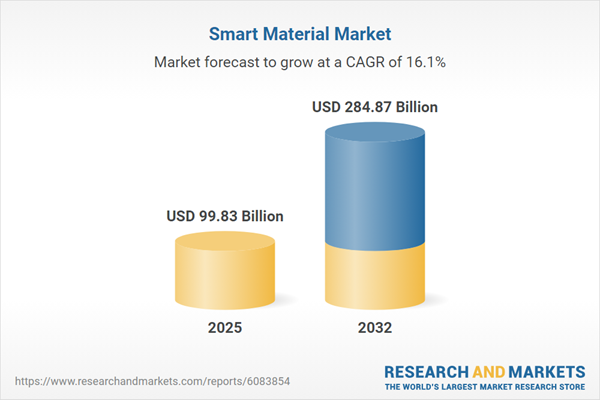Speak directly to the analyst to clarify any post sales queries you may have.
The smart materials market is rapidly advancing as adaptive technologies drive innovation across numerous sectors, offering both operational benefits and new application frontiers for organizations worldwide.
Market Snapshot: Smart Materials Market Overview and Growth Trajectory
The Smart Materials Market grew from USD 86.04 billion in 2024 to USD 99.83 billion in 2025. It is expected to continue expanding at a CAGR of 16.14%, reaching USD 284.87 billion by 2032.
This sustained growth is propelled by increased demand for adaptive solutions in industries like aerospace, automotive, healthcare, consumer electronics, and construction. As companies seek materials that deliver real-time responsiveness, energy efficiency, and durability, smart material technologies are playing a pivotal role in transforming both products and production processes.Scope & Segmentation of the Smart Materials Market
- Material Types: Electroactive Polymers (Conductive Polymers, Dielectric Elastomers, Ionic Polymer Metal Composites); Magnetostrictive Materials (Galfenol, Terfenol D); Piezoelectric Materials (Lead Zirconate Titanate, Quartz); Shape Memory Alloys (Copper Aluminum Nickel, Copper Zinc Aluminum, Nickel Titanium); Thermoelectric Materials (Bismuth Telluride, Silicon Germanium, Skutterudites).
- Applications: Aerospace (Actuation Systems, Structural Components); Automotive (Electric Vehicles, Engine Components, Interiors); Construction; Consumer Electronics (Smartphones, Wearable Devices); Healthcare (Drug Delivery Systems, Medical Implants); Textiles.
- Regional Coverage: Americas (United States, Canada, Mexico, Brazil, Argentina, Chile, Colombia, Peru); Europe, Middle East & Africa (United Kingdom, Germany, France, Russia, Italy, Spain, Netherlands, Sweden, Poland, Switzerland, United Arab Emirates, Saudi Arabia, Qatar, Turkey, Israel, South Africa, Nigeria, Egypt, Kenya); Asia-Pacific (China, India, Japan, Australia, South Korea, Indonesia, Thailand, Malaysia, Singapore, Taiwan).
- Key Companies: 3M Company, BASF SE, Honeywell International Inc., Dow Inc., Compagnie de Saint-Gobain S.A., Siemens Aktiengesellschaft, TE Connectivity Ltd., Koninklijke DSM N.V., Arkema S.A., DuPont de Nemours, Inc.
Key Takeaways for Smart Materials Stakeholders
- The evolution of smart materials integrates advanced engineering, emerging manufacturing technologies, and data-driven design to create adaptive solutions for both established and new applications.
- Cross-industry collaboration is enabling breakthroughs in multifunctional performance, including sensing, self-healing, actuation, and energy harvesting capabilities.
- Sustainability and regulatory compliance are driving the shift toward recyclable and environmentally responsible materials, influencing sourcing and production strategies globally.
- Integration with the Industrial Internet of Things (IIoT) and Industry 4.0 is positioning smart materials as key enablers of real-time monitoring and predictive maintenance in critical infrastructure and high-performance devices.
- Segment performance and success hinge on tailoring material selection and integration strategies to specific application requirements and end-market needs.
Tariff Impact on Global Supply Chains
The introduction of United States trade tariffs in 2025 affected sourcing, pricing, and logistics for vital materials such as rare earth elements and specialty polymers. Companies responded by diversifying supplier networks, investing in advanced shipment tracking, and forming regional consortia to support manufacturing resilience. These adjustments underscored the importance of robust procurement frameworks and adaptive inventory models for minimizing disruptions. Tariff-induced pressures prompted strategic collaboration across public and private sectors to ensure supply continuity, particularly for downstream industries like automotive, healthcare, and consumer electronics.
Methodology & Data Sources
This report is based on primary interviews with material scientists, executives, and sector experts, complemented by secondary research from peer-reviewed articles, government publications, patent analyses, and industry association reports. Systematic cross-referencing and expert panel validation were central to ensuring comprehensive, accurate, and actionable insights into market dynamics and emerging trends.
Why This Report Matters for Senior Decision Makers
- Provides a strategic roadmap for leveraging emerging smart material technologies to drive operational efficiency and competitive differentiation.
- Identifies regional growth opportunities and risk factors shaping sourcing, manufacturing, and commercialization strategies worldwide.
- Equips leaders with insights on regulatory trends, supply chain resilience, and ecosystem collaboration to inform long-term investment and innovation planning.
Conclusion
The smart materials sector is advancing quickly, propelled by innovation, regulatory changes, and shifting supply chains. Senior leaders equipped with these insights are best positioned to harness growth opportunities and navigate evolving market complexities.
Table of Contents
3. Executive Summary
4. Market Overview
7. Cumulative Impact of Artificial Intelligence 2025
Companies Mentioned
The companies profiled in this Smart Material market report include:- 3M Company
- BASF SE
- Honeywell International Inc.
- Dow Inc.
- Compagnie de Saint-Gobain S.A.
- Siemens Aktiengesellschaft
- TE Connectivity Ltd.
- Koninklijke DSM N.V.
- Arkema S.A.
- DuPont de Nemours, Inc.
Table Information
| Report Attribute | Details |
|---|---|
| No. of Pages | 198 |
| Published | November 2025 |
| Forecast Period | 2025 - 2032 |
| Estimated Market Value ( USD | $ 99.83 Billion |
| Forecasted Market Value ( USD | $ 284.87 Billion |
| Compound Annual Growth Rate | 16.1% |
| Regions Covered | Global |
| No. of Companies Mentioned | 11 |









